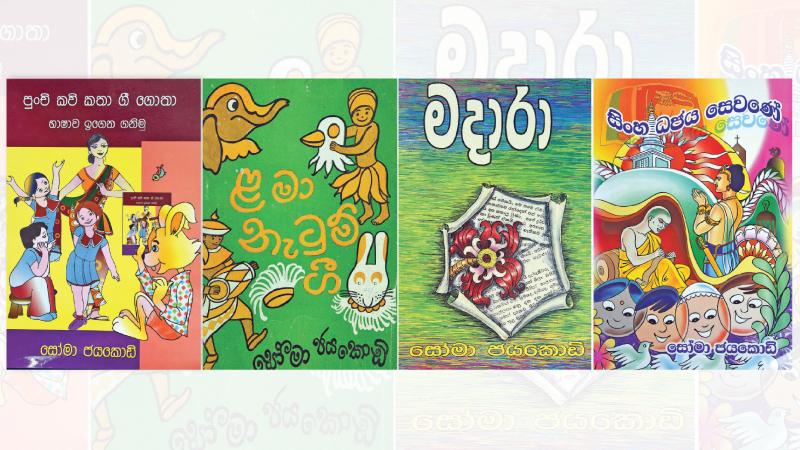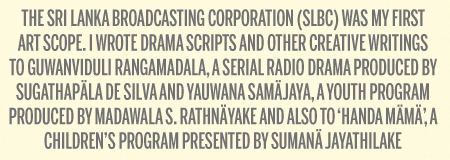
Soma Jayakody, the veteran Sinhala writer who published over 300 books, including popular Madara, Rangira, Densil Kobbekaduwa, Raja Bhawathu Dammiko, Jana Adipathiyek Samaga, and various children’s books, educational books and radio drama books, spoke to the Sunday Observer about her literary journey. Soma Jayakody, the author published 17 novels in Sinhala newspapers. Some of them have been translated into English and Tamil as well.
Excerpts
Q. Tell us about your family background and early education?
 Soma Jayakody
|
A. My hometown is Udabage, Deraniyagala. My father was a field supervisor at the Udabage plantations and I was born there. My father moved to Avissawella Estate in Puwakpitya to give us a good education as Udabage lacked proper educational facilities. My first school was Puwakpitiya South Vidyalaya where I studied up to Grade Eight. It was a Catholic school which had both Sinhalese and Tamils. For my O/L, I joined Puwakpitiya North Vidyalaya and for A/Ls, Mahinda Maha Vidyalaya, Nuwara Eliya. I have two sisters and four brothers. I am the fifth of the family. Now, three of them have died.
Q. How made you join in the literary field?
A: My parents always read books. I remember my father read aloud Vessanthara Jatakaya, one of Jataka stories to us in most evenings. It was so emotional that tears fell from my eyes. When he saw me crying, he once again read the Jataka story. Then I cried more. I thought why I couldn’t write a story like that. My father had made me keep a diary. I started to write my day-to-day activities in the diary. I began to write poems and essays to newspapers. A Vesak magazine featured one of my poems when I was 13. After that, I regularly wrote articles to newspapers.
Q. Then you started to write radio dramas?
A. Yes. The Sri Lanka Broadcasting Corporation (SLBC) was my first art scope. I wrote drama scripts and other creative writings for Guwanviduli Rangamadala, a serial radio drama produced by Sugathapäla de Silva and Yauwana Samäjaya, a youth program produced by Madawala S. Rathnäyake and also to Handa Mämä, a children’s program presented by Sumanä Jayathilake. I remember winning the prize of a book most of the time when I wrote a poem or prose to the Handa Mämä program. Our gurus at the SLBC were Sugathapala de Silva, Madawala S. Rathnayake, Dayananda Gunawardhane and Sumanä Jayathilake who wanted to develop a new generation of creative writers and a radio drama literature.
They summoned us to the SLBC to record the programs when we sent a good radio drama script or any other creative work. When we were at the studio, they instructed us how to improve and correct our writings. Once, Sugathapäla de Silva told me that, “if you want to be a good writer, you need to have a free and independent mind”. Following their advice, we built our writing skills and sharpened creativity. This type of mentors cannot be seen these days in the art scope.
Q. How many radio drama scripts have you published?
A. I have published ten radio drama books, while I have written 85 radio dramas.
Q. Haven’t you met Prof Sarachchandra?
A. I never met him at the SLBC, but I met him once or twice in other places. I had sent him a short review by reading his novel, Malagiya Aththö. In the review while I praised the book, I questioned him, “Do all Sri Lankans, who visit Japan, commit suicide by taking an overdose of sleeping pills?” He sent me a reply saying he would like to talk about it, but that never materialised.
Q. How did you publish your first book?
A. It was a children’s book titled Japan Sahödariyan Thidenä (‘Three Japanese Sisters’). That became a reality thanks to the financial support provided through the writers’ assistance project launched by the National Library Service and Documentation Board. The book was published by Godage Publishers in 1987. The negotiator who introduced me to Godagë mahatthaya was Lakshman Kahatapitiya, a veteran Sinhala writer who worked at the Godagë Publishing House.
Q. How was the response from your parents for your writing?
A. They were overjoyed by it. When my father was on his death bed, there were two books under his pillow which were one of Dharmasiri Gamage’s short story book and one of my novels, Balawatthu and Bawalatthu.
Q. Your most popular book is the novel, Madarä.
A. Yes. Madarä has been published ten times. It deals with a political issue that plagued Sri Lanka some 30 years ago. When President R. Premadasa was in power, there was no intellectual discourse, artistic discussion or creative work launched in Sri Lanka. The whole country was in terror. Intellectuals, politicians, artistes and the youth were murdered in cold blood. I described the situation in my novel. As the novel serialised on the Divayina newspaper, it became popular. Its English translation was also serialised on a newspaper.
Q. How was Madarä published on a newspaper?
 A. When I finished the manuscript, I visited Lassana Prakäshakayö, a publishing house at Wellampitiya. They declined the publishing saying they would like to publish a children’s book. I had published a few children’s books, and they knew me as a children’s book author. I had no option, but to send it to a newspaper for a serialised publication.
A. When I finished the manuscript, I visited Lassana Prakäshakayö, a publishing house at Wellampitiya. They declined the publishing saying they would like to publish a children’s book. I had published a few children’s books, and they knew me as a children’s book author. I had no option, but to send it to a newspaper for a serialised publication.
I made a summary of the novel and posted it to Divayina. Edmond Ranasinghe, the then Sunday Divayina Chief Editor, had read the summary and referred it to Gamini Sumanasëkara, the Deputy Editor.
They informed me by a letter to meet Edmond Ranasinghe. When I met him, he agreed to serialise in on Divayina.
Q. You never won a literary award?
A. I never won a state literary award. As I heard, the reason for it was my subject matter which is socio-political issues. My people and the country are more important than awards for me. However, I was awarded an honorary title as Samaja Subhasadhini and Jana Prasadini by the Thrinikayika Sanga Sabha. I was selected twice as the most popular novelist in the country from a survey by the Divayina and the Lankadeepa newspapers.
Q. Newspaper novels are regarded as low level literature or pulp fiction. What is your view?
A. When I write a newspaper novel, I try to limit my handwritten pages to six for a week. I have to condense some incidents that I describe. But you cannot say it’s low literature only because of that.
Q. You always have to maintain the tension of a newspaper novel with curiosity which is not a good quality in an artistic novel?
A. We have to keep the reader in curiosity. But curiosity is not a bad quality. You cannot read a novel without curiosity.
Q. Who influenced your literary career?
A. Every writer I read influenced me. Some novels I like very much are Miniwan P. Thilakarathane’s Gamaka Watha, Amarageewa Widyarathne’s Palingu Prathima, G.B. Senanayake’s novels, Marie Corelli’s novel Thelma, Charles Dickens’ David Copperfield and a Russian children’s book, Lassana Wasileessa.
